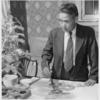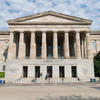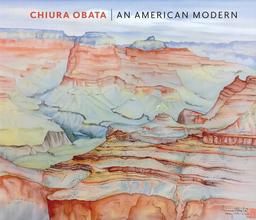More about Lake Basin in the High Sierra
- All
- Info
- Shop

Contributor
Lake Basin in the High Sierra is part of Chiura Obata’s iconic World Landscape Series, and an expression of his poetic vision of nature imbued with Zen philosophy.
Good things take time. Sometimes, they take a lot of time. And the World Landscape Series: America took over one and a half years, 32 carvers, 40 printers, and all of Chiura Obata's savings to be completed. With a perfectionist's eye, the Japanese-American artist spared no cost in his effort to immortalize what he cherished most - the impressive landscapes of America’s West.
In the summer of 1927, Obata embarked on a journey through California’s Yosemite National Park, upon the invitation of his artist friend and UC Berkeley professor Worth Ryder. Over a period of two months, they drove past monumental mountains, camped in the wild, and hiked serene nature trails, drank sake by a campfire and went fishing in mountain streams - and, of course, painted and sketched. It was a perfect setting for Obata to become inspired, not only artistically, but also spiritually. “This morning I woke up at 2 o’clock and I saw the moon shining in the woods, on the river, and in the meadow," Obata wrote in one of his letters to his wife. "It evoked in me the days of the gods.”
Maybe it was for this reason that he adopted the name “World landscape" for his series, a term that is derived from the German “Weltlandschaft," a type of landscape painting that was historically concerned with Biblical and mythical narratives, and in which human figures are dwarfed by the nature around them. Obata’s reverence of nature, rooted in his Buddhist views was inseparable from his work. He stated about the view that he immortalized into this iconic painting, “Man’s very soul and body seem to melt away into the singular silence and tranquility of the surrounding air."
The inspiration he found in Yosemite was to become his most famous work, which in turn opened the gateway to his career as an influential art professor at UC Berkeley. He produced a prolific portfolio of about 100 sketches and paintings documenting the diverse expressions of nature. Back in Japan, he turned some of these into woodblock prints that now make up the World Landscape Series, consisting of a total of 35 compositions, and a mind-blowing 400 impressions were made for each of the 35 motives. Only the finest 100 were selected, and the less perfect ones, numbering more than 10,000, were destroyed.
Through his signature style, merging modernism with traditional Japanese ink drawing and watercolor techniques, Obata’s depictions of Yosemite went beyond what had already been captured by other accomplished painters, such as Albert Bierstadt and Thomas Hill. Instead of reproducing another theatrical version of the panoramic landscape drenched in the golden light of a sunset, Obata focused on details. With simple lines and bold brushstrokes he portrayed rock formations, crooked tree branches, and placid mountain lakes. His plain and cropped compositions resulted in strikingly graphic images. It was exactly this minimalist style that spoke to Obata’s American audiences, providing them with a fresh vision of their landscapes, and proof that sometimes, less is more.
These works were also perhaps a small step towards fostering understanding between cultures during an era when anti-Asian racism was rife in America. With the World Landscape Series, Obata chose the subject that he viewed as the source of peace for every human being in its ability to transcend nationality, politics and war - nature.
Sources
- Ault, Alicia. “How Japanese Artist Chiura Obata came to be an American Great.” Smithsonian Magazine. January 29, 2020. https://www.smithsonianmag.com/smithsonian-institution/how-japanese-art….
- Bahadur, Tulika. “Joachim Patinir: Inventor of the ‘World Landscape’.” On Art and Aesthetics. March 10, 2017. https://onartandaesthetics.com/2017/03/10/joachim-patinir-inventor-of-t…
- Burgard, Timothy A. “Chiura Obata and the Restorative Powers of ‘Great Nature’.” Fine Arts Museum of San Francisco. March 26, 2020. https://www.famsf.org/chiura-obata-and-nature.
- Crocker Art Museum. "Chiura Obata: An American Modern.” April 16, 2019. https://www.crockerart.org/oculus/chiura-obata-an-american-modern.
- Crocker Art Museum. "’Chiura Obata: An American Modern’ Spans Japanese American Painter’s 70-Year Career.” July 19, 2019. https://www.crockerart.org/press/obata.
- Egenolf Gallery. “Chiura Obata.” Accessed April 05, 2022. https://egenolfgallery.com/collections/obata
- Fancher, Lou. “Chiura Obata: A story of resilience, a passion for Yosemite.” Berkeleyside. December 19, 2014. https://www.berkeleyside.org/2014/12/19/chiura-obata-a-story-of-resilie….
- Fine Arts Museum of San Francisco. “Great Nature: The Transcendent Landscapes of Chiura Obata.” Accessed April 05, 2022. http://www.tfaoi.com/aa/2aa/2aa85.htm.
- Hogan, Meghan. “Obata’s Yosemite: Chiura Obata’s Brush with Zen in the High Sierra’s.” Common Ground. Fall 2009. https://www.nps.gov/commonground/fall2009/fea2_fall09.pdf.
- Osaka Prints. “Archive: Chiura Obata”. Accessed April 05, 2022. https://www.osakaprints.com/content/artists/info_pp/obata_info/obata_10…
- Popova, Maria. “Chiura Obata’s Stunning Paintings of Yosemite.” The Marginalian. Accessed February 27, 2022. https://www.themarginalian.org/2018/03/23/chiura-obata-yosemite/.
- Prodger, Michael. “How Chiura Obata Combined the Traditions of Japanese and American Art.” The New Statesman. October 27, 202. https://www.newstatesman.com/culture/art-design/the-greats-outdoors/202….
- Saint Louis Art Museum. “Setting Sun of Sacramento Valley.” Accessed February 27, 2022. https://www.slam.org/collection/objects/26822/.
- Smithsonian American Art Museum. “Chiura Obata: American Modern.” Accessed February 27, 2022. https://americanart.si.edu/exhibitions/obata
- Siber, Kate. “Wood Blocks and Water Colors.” National Parks Conservation Association. Summer 2013. https://www.npca.org/articles/1041-wood-blocks-water-colors
- Sullivan Goss. “Chiura Obata (1885-1975).” Accessed February 27, 2022. https://www.sullivangoss.com/artists/chiura-obata-1885-1975.
- The Annex Galleries. “Chiura Obata: Biography.” Accessed February 27, 2022. https://www.annexgalleries.com/artists/biography/1767/Obata/Chiura.
- Trotter Galleries, Inc. “Chiura Obata Biography.” Accessed February 27, 2022. https://www.trottergalleries.com/inventory/artist-bio/?at=ChiuraObata.
- Wilson, Scott. “See America through the Eyes of Chiura Obata, a Japanese Artist from the early 1900s.”. Sora News 24. November 20, 2015. https://soranews24.com/2015/11/20/see-america-through-the-eyes-of-chiur….
- Winther-Tamaki, Bert. “Overtly, Covertly, or Not at All: Putting ‘Japan’ in Japanese American Painting.” East-West Interchanges in American Art. February 21, 2012. https://repository.si.edu/bitstream/handle/10088/17971/112-125_Winther-….












